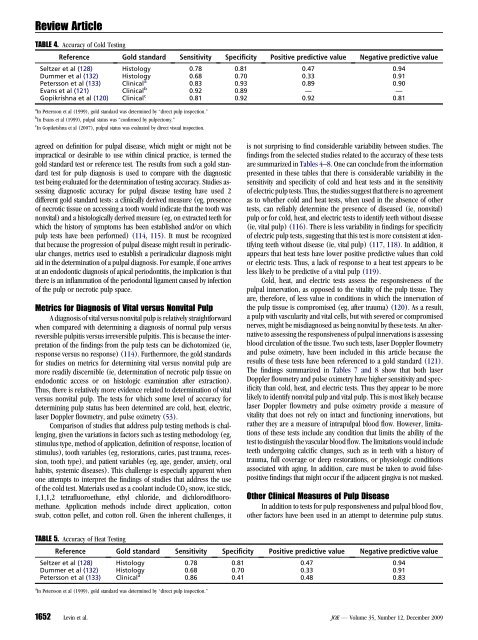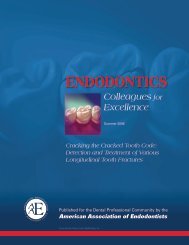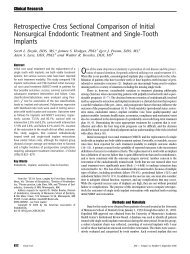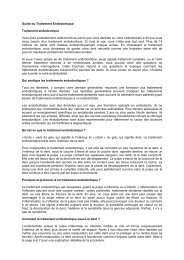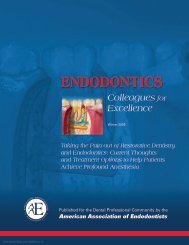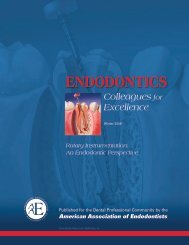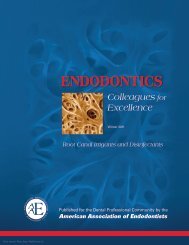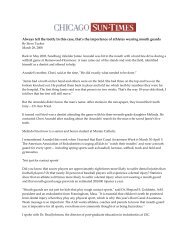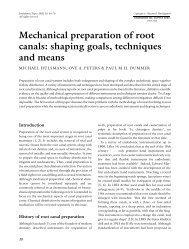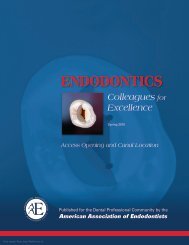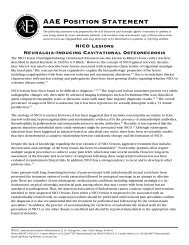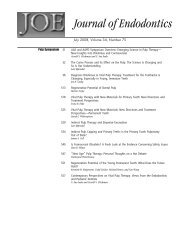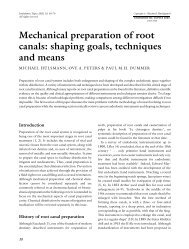Identify and Define All Diagnostic Terms for Pulpal - American ...
Identify and Define All Diagnostic Terms for Pulpal - American ...
Identify and Define All Diagnostic Terms for Pulpal - American ...
Create successful ePaper yourself
Turn your PDF publications into a flip-book with our unique Google optimized e-Paper software.
Review Article<br />
TABLE 4. Accuracy of Cold Testing<br />
Reference Gold st<strong>and</strong>ard Sensitivity Specificity Positive predictive value Negative predictive value<br />
Seltzer et al (128) Histology 0.78 0.81 0.47 0.94<br />
Dummer et al (132) Histology 0.68 0.70 0.33 0.91<br />
Petersson et al (133) Clinical a<br />
0.83 0.93 0.89 0.90<br />
Evans et al (121) Clinical b<br />
0.92 0.89 — —<br />
Gopikrishna et al (120) Clinical c<br />
0.81 0.92 0.92 0.81<br />
a<br />
In Petersson et al (1999), gold st<strong>and</strong>ard was determined by ‘‘direct pulp inspection.’’<br />
b<br />
In Evans et al (1999), pulpal status was ‘‘confirmed by pulpectomy.’’<br />
c<br />
In Gopikrishna et al (2007), pulpal status was evaluated by direct visual inspection.<br />
agreed on definition <strong>for</strong> pulpal disease, which might or might not be<br />
impractical or desirable to use within clinical practice, is termed the<br />
gold st<strong>and</strong>ard test or reference test. The results from such a gold st<strong>and</strong>ard<br />
test <strong>for</strong> pulp diagnosis is used to compare with the diagnostic<br />
test being evaluated <strong>for</strong> the determination of testing accuracy. Studies assessing<br />
diagnostic accuracy <strong>for</strong> pulpal disease testing have used 2<br />
different gold st<strong>and</strong>ard tests: a clinically derived measure (eg, presence<br />
of necrotic tissue on accessing a tooth would indicate that the tooth was<br />
nonvital) <strong>and</strong> a histologically derived measure (eg, on extracted teeth <strong>for</strong><br />
which the history of symptoms has been established <strong>and</strong>/or on which<br />
pulp tests have been per<strong>for</strong>med) (114, 115). It must be recognized<br />
that because the progression of pulpal disease might result in periradicular<br />
changes, metrics used to establish a periradicular diagnosis might<br />
aid in the determination of a pulpal diagnosis. For example, if one arrives<br />
at an endodontic diagnosis of apical periodontitis, the implication is that<br />
there is an inflammation of the periodontal ligament caused by infection<br />
of the pulp or necrotic pulp space.<br />
Metrics <strong>for</strong> Diagnosis of Vital versus Nonvital Pulp<br />
A diagnosis of vital versus nonvital pulp is relatively straight<strong>for</strong>ward<br />
when compared with determining a diagnosis of normal pulp versus<br />
reversible pulpitis versus irreversible pulpitis. This is because the interpretation<br />
of the findings from the pulp tests can be dichotomized (ie,<br />
response versus no response) (114). Furthermore, the gold st<strong>and</strong>ards<br />
<strong>for</strong> studies on metrics <strong>for</strong> determining vital versus nonvital pulp are<br />
more readily discernible (ie, determination of necrotic pulp tissue on<br />
endodontic access or on histologic examination after extraction).<br />
Thus, there is relatively more evidence related to determination of vital<br />
versus nonvital pulp. The tests <strong>for</strong> which some level of accuracy <strong>for</strong><br />
determining pulp status has been determined are cold, heat, electric,<br />
laser Doppler flowmetry, <strong>and</strong> pulse oximetry (53).<br />
Comparison of studies that address pulp testing methods is challenging,<br />
given the variations in factors such as testing methodology (eg,<br />
stimulus type, method of application, definition of response, location of<br />
stimulus), tooth variables (eg, restorations, caries, past trauma, recession,<br />
tooth type), <strong>and</strong> patient variables (eg, age, gender, anxiety, oral<br />
habits, systemic diseases). This challenge is especially apparent when<br />
one attempts to interpret the findings of studies that address the use<br />
of the cold test. Materials used as a coolant include CO 2 snow, ice stick,<br />
1,1,1,2 tetrafluoroethane, ethyl chloride, <strong>and</strong> dichlorodifluoromethane.<br />
Application methods include direct application, cotton<br />
swab, cotton pellet, <strong>and</strong> cotton roll. Given the inherent challenges, it<br />
is not surprising to find considerable variability between studies. The<br />
findings from the selected studies related to the accuracy of these tests<br />
are summarized in Tables 4–8. One can conclude from the in<strong>for</strong>mation<br />
presented in these tables that there is considerable variability in the<br />
sensitivity <strong>and</strong> specificity of cold <strong>and</strong> heat tests <strong>and</strong> in the sensitivity<br />
of electric pulp tests. Thus, the studies suggest that there is no agreement<br />
as to whether cold <strong>and</strong> heat tests, when used in the absence of other<br />
tests, can reliably determine the presence of diseased (ie, nonvital)<br />
pulp or <strong>for</strong> cold, heat, <strong>and</strong> electric tests to identify teeth without disease<br />
(ie, vital pulp) (116). There is less variability in findings <strong>for</strong> specificity<br />
of electric pulp tests, suggesting that this test is more consistent at identifying<br />
teeth without disease (ie, vital pulp) (117, 118). In addition, it<br />
appears that heat tests have lower positive predictive values than cold<br />
or electric tests. Thus, a lack of response to a heat test appears to be<br />
less likely to be predictive of a vital pulp (119).<br />
Cold, heat, <strong>and</strong> electric tests assess the responsiveness of the<br />
pulpal innervation, as opposed to the vitality of the pulp tissue. They<br />
are, there<strong>for</strong>e, of less value in conditions in which the innervation of<br />
the pulp tissue is compromised (eg, after trauma) (120). As a result,<br />
a pulp with vascularity <strong>and</strong> vital cells, but with severed or compromised<br />
nerves, might be misdiagnosed as being nonvital by these tests. An alternative<br />
to assessing the responsiveness of pulpal innervations is assessing<br />
blood circulation of the tissue. Two such tests, laser Doppler flowmetry<br />
<strong>and</strong> pulse oximetry, have been included in this article because the<br />
results of these tests have been referenced to a gold st<strong>and</strong>ard (121).<br />
The findings summarized in Tables 7 <strong>and</strong> 8 show that both laser<br />
Doppler flowmetry <strong>and</strong> pulse oximetry have higher sensitivity <strong>and</strong> specificity<br />
than cold, heat, <strong>and</strong> electric tests. Thus they appear to be more<br />
likely to identify nonvital pulp <strong>and</strong> vital pulp. This is most likely because<br />
laser Doppler flowmetry <strong>and</strong> pulse oximetry provide a measure of<br />
vitality that does not rely on intact <strong>and</strong> functioning innervations, but<br />
rather they are a measure of intrapulpal blood flow. However, limitations<br />
of these tests include any condition that limits the ability of the<br />
test to distinguish the vascular blood flow. The limitations would include<br />
teeth undergoing calcific changes, such as in teeth with a history of<br />
trauma, full coverage or deep restorations, or physiologic conditions<br />
associated with aging. In addition, care must be taken to avoid falsepositive<br />
findings that might occur if the adjacent gingiva is not masked.<br />
Other Clinical Measures of Pulp Disease<br />
In addition to tests <strong>for</strong> pulp responsiveness <strong>and</strong> pulpal blood flow,<br />
other factors have been used in an attempt to determine pulp status.<br />
TABLE 5. Accuracy of Heat Testing<br />
Reference Gold st<strong>and</strong>ard Sensitivity Specificity Positive predictive value Negative predictive value<br />
Seltzer et al (128) Histology 0.78 0.81 0.47 0.94<br />
Dummer et al (132) Histology 0.68 0.70 0.33 0.91<br />
Petersson et al (133) Clinical a<br />
0.86 0.41 0.48 0.83<br />
a In Petersson et al (1999), gold st<strong>and</strong>ard was determined by ‘‘direct pulp inspection.’’<br />
1652 Levin et al. JOE — Volume 35, Number 12, December 2009


